Workplace Cohesion: HRM Practices and its Relevance in Australia
VerifiedAdded on 2019/11/20
|11
|2414
|147
Report
AI Summary
This report investigates workplace cohesion within the context of human resource management (HRM) practices in Australia. It commences by defining cohesion and identifying the traits that enhance it, followed by an exploration of multiculturalism and multi-racialism, and how these factors contribute to cohesion. The report then examines the pivotal role of HRM and management practices in fostering cohesion, including workforce diversity strategies, equity in standards, and compliance with regulations. It also discusses management practices that promote cohesion, such as ethical conduct and customer relations. Furthermore, the report highlights the advantages and disadvantages of workplace cohesion, addressing potential setbacks like misconceptions and discriminatory policies. Ultimately, this report provides a comprehensive overview of workplace cohesion, offering valuable insights into its significance and the strategies for its effective implementation within Australian workplaces.
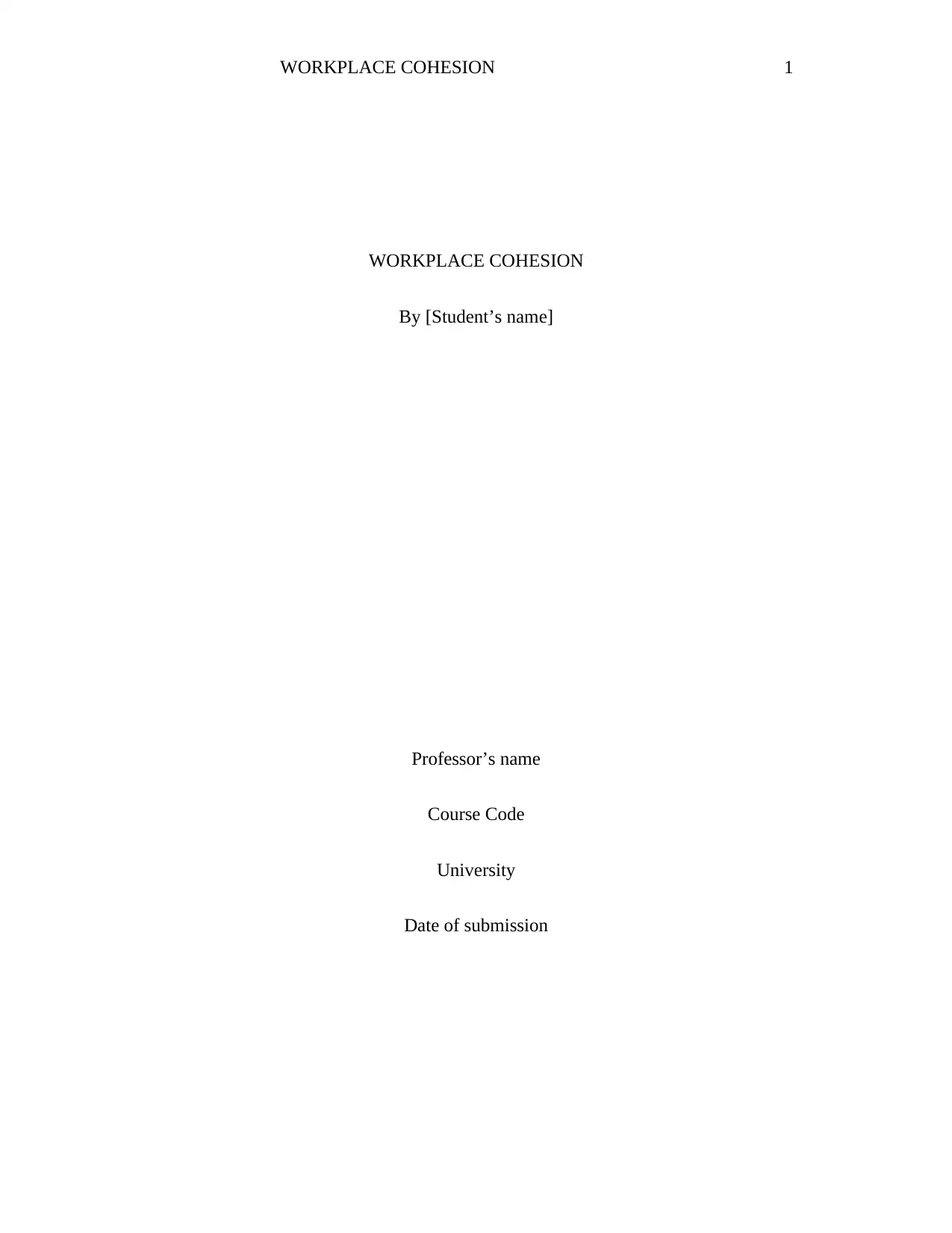
WORKPLACE COHESION 1
WORKPLACE COHESION
By [Student’s name]
Professor’s name
Course Code
University
Date of submission
WORKPLACE COHESION
By [Student’s name]
Professor’s name
Course Code
University
Date of submission
Paraphrase This Document
Need a fresh take? Get an instant paraphrase of this document with our AI Paraphraser
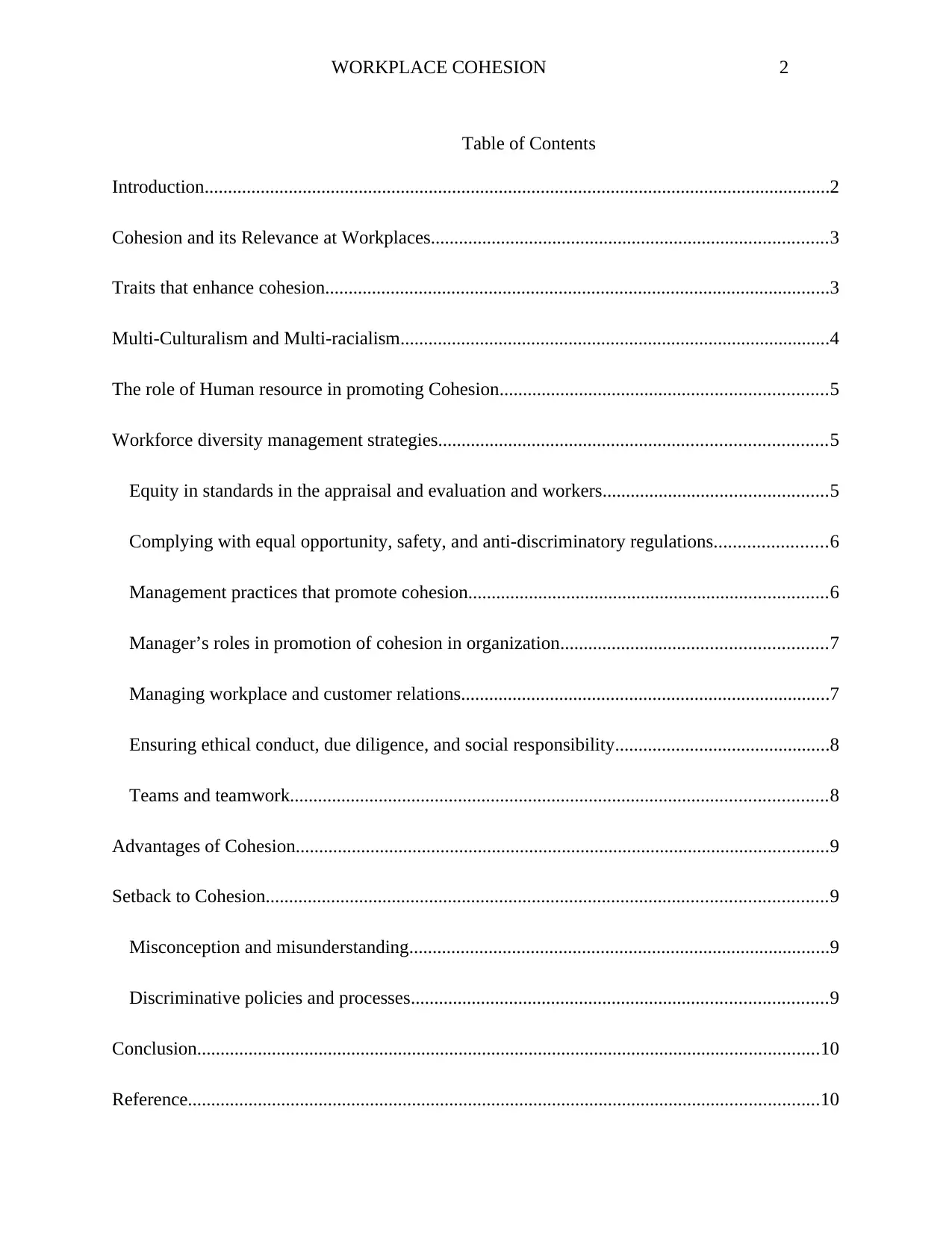
WORKPLACE COHESION 2
Table of Contents
Introduction......................................................................................................................................2
Cohesion and its Relevance at Workplaces.....................................................................................3
Traits that enhance cohesion............................................................................................................3
Multi-Culturalism and Multi-racialism............................................................................................4
The role of Human resource in promoting Cohesion......................................................................5
Workforce diversity management strategies...................................................................................5
Equity in standards in the appraisal and evaluation and workers................................................5
Complying with equal opportunity, safety, and anti-discriminatory regulations........................6
Management practices that promote cohesion.............................................................................6
Manager’s roles in promotion of cohesion in organization.........................................................7
Managing workplace and customer relations...............................................................................7
Ensuring ethical conduct, due diligence, and social responsibility..............................................8
Teams and teamwork...................................................................................................................8
Advantages of Cohesion..................................................................................................................9
Setback to Cohesion........................................................................................................................9
Misconception and misunderstanding..........................................................................................9
Discriminative policies and processes.........................................................................................9
Conclusion.....................................................................................................................................10
Reference.......................................................................................................................................10
Table of Contents
Introduction......................................................................................................................................2
Cohesion and its Relevance at Workplaces.....................................................................................3
Traits that enhance cohesion............................................................................................................3
Multi-Culturalism and Multi-racialism............................................................................................4
The role of Human resource in promoting Cohesion......................................................................5
Workforce diversity management strategies...................................................................................5
Equity in standards in the appraisal and evaluation and workers................................................5
Complying with equal opportunity, safety, and anti-discriminatory regulations........................6
Management practices that promote cohesion.............................................................................6
Manager’s roles in promotion of cohesion in organization.........................................................7
Managing workplace and customer relations...............................................................................7
Ensuring ethical conduct, due diligence, and social responsibility..............................................8
Teams and teamwork...................................................................................................................8
Advantages of Cohesion..................................................................................................................9
Setback to Cohesion........................................................................................................................9
Misconception and misunderstanding..........................................................................................9
Discriminative policies and processes.........................................................................................9
Conclusion.....................................................................................................................................10
Reference.......................................................................................................................................10

WORKPLACE COHESION 3
Introduction
Cohesion is one of the critical human resource aspects of every business organization.
This research paper discusses cohesion as guided by the human resource management practices
in Australia. It defines cohesion and traits aligned or giving rise to it. Also, the report reviews
multi-culturalism and multi-racialism and ways through which they contribute to cohesion.
Further, it establishes the role of human resource and the management practices in the promotion
of cohesion in the organization. Finally, the paper discusses the advantages and setbacks of
cohesion in the workplace and concludes the research paper. Thus, this report is useful in
revealing the organization’s aspects of cohesion.
Cohesion and its Relevance at Workplaces
Cohesion is the act of improving individual bond to form close relationship amongst
people. The increased market competition and dynamic nature of business around the world have
led to the globalization of organizations to achieve competitive advantages and increase their
market share. Due to these facts, companies have decided to re-structure their human resource
operations and strategies by recruiting employees across the globe to improve on their
competencies and harness a vast knowledge and experience. As the result of changing workforce
demographics, there is an increased need for managing the diversity in Australian workplaces to
ensure cohesion, cooperation and unison spirit in the workplace.
Introduction
Cohesion is one of the critical human resource aspects of every business organization.
This research paper discusses cohesion as guided by the human resource management practices
in Australia. It defines cohesion and traits aligned or giving rise to it. Also, the report reviews
multi-culturalism and multi-racialism and ways through which they contribute to cohesion.
Further, it establishes the role of human resource and the management practices in the promotion
of cohesion in the organization. Finally, the paper discusses the advantages and setbacks of
cohesion in the workplace and concludes the research paper. Thus, this report is useful in
revealing the organization’s aspects of cohesion.
Cohesion and its Relevance at Workplaces
Cohesion is the act of improving individual bond to form close relationship amongst
people. The increased market competition and dynamic nature of business around the world have
led to the globalization of organizations to achieve competitive advantages and increase their
market share. Due to these facts, companies have decided to re-structure their human resource
operations and strategies by recruiting employees across the globe to improve on their
competencies and harness a vast knowledge and experience. As the result of changing workforce
demographics, there is an increased need for managing the diversity in Australian workplaces to
ensure cohesion, cooperation and unison spirit in the workplace.
⊘ This is a preview!⊘
Do you want full access?
Subscribe today to unlock all pages.

Trusted by 1+ million students worldwide

WORKPLACE COHESION 4
Traits that enhance cohesion
The culture of Australia upholds and value, authenticity, and sincerity. Australians prefer
people who are modest, humble, self-deprecating and with a sense of humor. Further, they do not
draw attention to their academic or other achievements and tend to distrust people who do. They
often downplay their success which portrays them as not to be achievement-oriented (Zierscha,
Gallahera, Bauma and Bentleya, 2011, pp. 1045–1053).
Multi-Culturalism and Multi-racialism
The concept and practice of diversity management, multi-culturalism and multi-racialism
have evolved over decades of years catalyzed by the emergent of an immigrant population. On
the onset of fighting racialism and cultural cocoons, the government of Australia introduced
legislation that checked discrimination vices based on race and culture. This legislation promoted
equal opportunity and occupational health and safety indiscriminately. To this effect,
organizations had the task of compliance with the legislation to avoid misfortunes of lawsuits
and harsh penalties, reputation dents and cheap workers morale after reduced productivity
(Huang and Hsueh, 2007, pp. 265–271).
Australia is a multi-cultured and multi-racial country that accommodates shared values
and cultural traditions. Moreover, the country's legislation does not discriminate people from
many walks of life but offers a platform that is diverse and broad evident in country's food,
lifestyle and cultural practices and experience. It is for these reasons that the state has adopted
best practices in human resource management for effective diversity management (Ruteere,
2012). Further, the multi-culturalism and multi-racialism factors recognize the diversity of the
Traits that enhance cohesion
The culture of Australia upholds and value, authenticity, and sincerity. Australians prefer
people who are modest, humble, self-deprecating and with a sense of humor. Further, they do not
draw attention to their academic or other achievements and tend to distrust people who do. They
often downplay their success which portrays them as not to be achievement-oriented (Zierscha,
Gallahera, Bauma and Bentleya, 2011, pp. 1045–1053).
Multi-Culturalism and Multi-racialism
The concept and practice of diversity management, multi-culturalism and multi-racialism
have evolved over decades of years catalyzed by the emergent of an immigrant population. On
the onset of fighting racialism and cultural cocoons, the government of Australia introduced
legislation that checked discrimination vices based on race and culture. This legislation promoted
equal opportunity and occupational health and safety indiscriminately. To this effect,
organizations had the task of compliance with the legislation to avoid misfortunes of lawsuits
and harsh penalties, reputation dents and cheap workers morale after reduced productivity
(Huang and Hsueh, 2007, pp. 265–271).
Australia is a multi-cultured and multi-racial country that accommodates shared values
and cultural traditions. Moreover, the country's legislation does not discriminate people from
many walks of life but offers a platform that is diverse and broad evident in country's food,
lifestyle and cultural practices and experience. It is for these reasons that the state has adopted
best practices in human resource management for effective diversity management (Ruteere,
2012). Further, the multi-culturalism and multi-racialism factors recognize the diversity of the
Paraphrase This Document
Need a fresh take? Get an instant paraphrase of this document with our AI Paraphraser
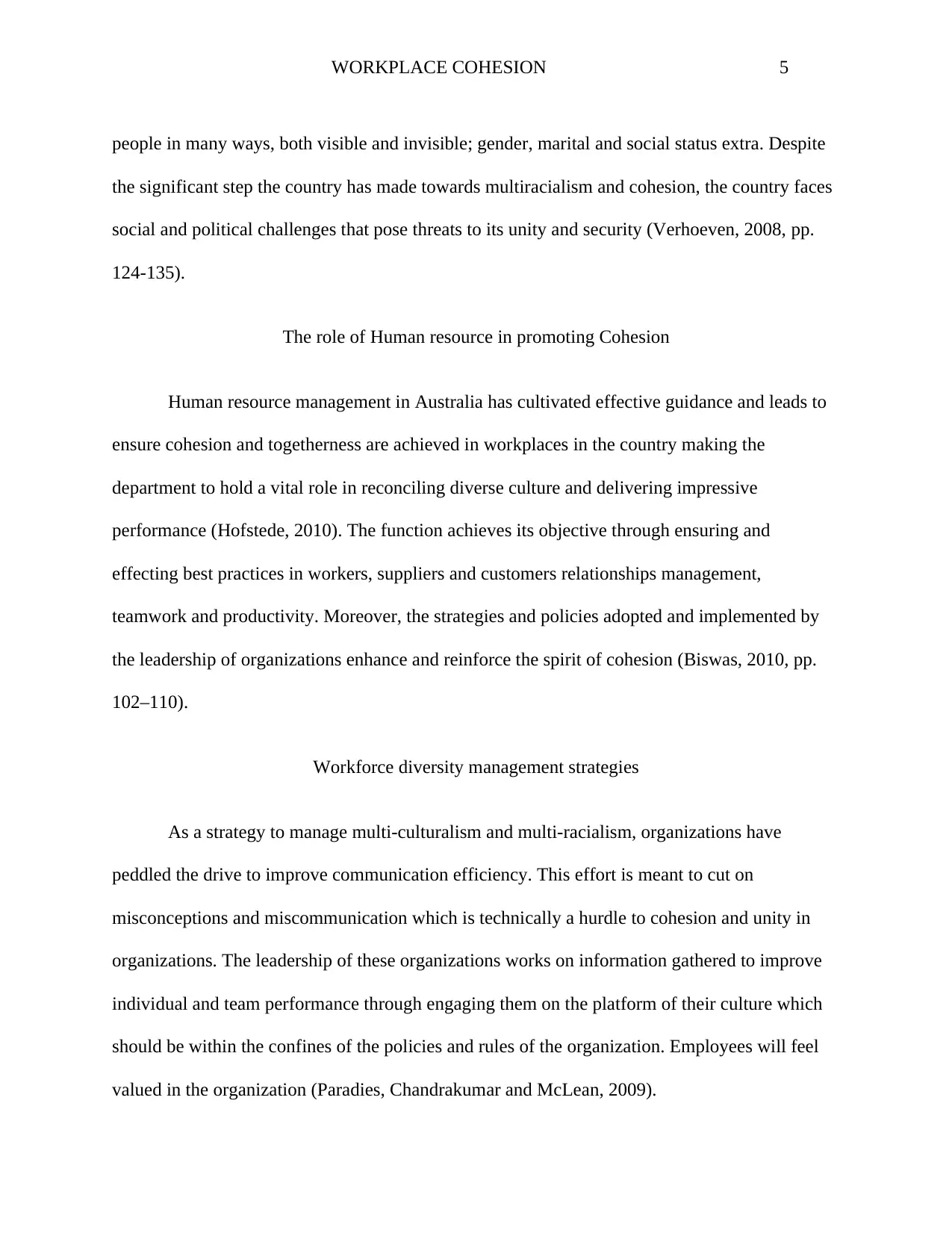
WORKPLACE COHESION 5
people in many ways, both visible and invisible; gender, marital and social status extra. Despite
the significant step the country has made towards multiracialism and cohesion, the country faces
social and political challenges that pose threats to its unity and security (Verhoeven, 2008, pp.
124-135).
The role of Human resource in promoting Cohesion
Human resource management in Australia has cultivated effective guidance and leads to
ensure cohesion and togetherness are achieved in workplaces in the country making the
department to hold a vital role in reconciling diverse culture and delivering impressive
performance (Hofstede, 2010). The function achieves its objective through ensuring and
effecting best practices in workers, suppliers and customers relationships management,
teamwork and productivity. Moreover, the strategies and policies adopted and implemented by
the leadership of organizations enhance and reinforce the spirit of cohesion (Biswas, 2010, pp.
102–110).
Workforce diversity management strategies
As a strategy to manage multi-culturalism and multi-racialism, organizations have
peddled the drive to improve communication efficiency. This effort is meant to cut on
misconceptions and miscommunication which is technically a hurdle to cohesion and unity in
organizations. The leadership of these organizations works on information gathered to improve
individual and team performance through engaging them on the platform of their culture which
should be within the confines of the policies and rules of the organization. Employees will feel
valued in the organization (Paradies, Chandrakumar and McLean, 2009).
people in many ways, both visible and invisible; gender, marital and social status extra. Despite
the significant step the country has made towards multiracialism and cohesion, the country faces
social and political challenges that pose threats to its unity and security (Verhoeven, 2008, pp.
124-135).
The role of Human resource in promoting Cohesion
Human resource management in Australia has cultivated effective guidance and leads to
ensure cohesion and togetherness are achieved in workplaces in the country making the
department to hold a vital role in reconciling diverse culture and delivering impressive
performance (Hofstede, 2010). The function achieves its objective through ensuring and
effecting best practices in workers, suppliers and customers relationships management,
teamwork and productivity. Moreover, the strategies and policies adopted and implemented by
the leadership of organizations enhance and reinforce the spirit of cohesion (Biswas, 2010, pp.
102–110).
Workforce diversity management strategies
As a strategy to manage multi-culturalism and multi-racialism, organizations have
peddled the drive to improve communication efficiency. This effort is meant to cut on
misconceptions and miscommunication which is technically a hurdle to cohesion and unity in
organizations. The leadership of these organizations works on information gathered to improve
individual and team performance through engaging them on the platform of their culture which
should be within the confines of the policies and rules of the organization. Employees will feel
valued in the organization (Paradies, Chandrakumar and McLean, 2009).

WORKPLACE COHESION 6
Equity in standards in the appraisal and evaluation and workers
The human resource needs to establish training and development areas to their employees
to ensure standardized performance that can be easily monitored, evaluated and benchmarked for
the goals and objectives of the organization (Daft and Marcic, 2009). Additionally, the HR
practices on career progression should adequately reflect and encompass diversity issues
otherwise some employees will develop negative perceptions in the whole process (Mulunga and
Yazdanifard, 2014, pp. 14–20).
Complying with equal opportunity, safety, and anti-discriminatory regulations
The policy of equalization on opportunities, rewards, and recognition is essential in
promoting cohesion. Moreover, panels evaluating and selecting individuals for promotions
should be objective and also panel to reflect diversity. Further, remuneration systems should be
accurate and-and operate on the principle of equity and performance-based pays (Demireva,
2014). This is inclusive of the wage determinants, and benefit schemes should reflect the
universal principles and consider each concerning their abilities, knowledge, and skills.
Management practices that promote cohesion
The organizations in Australia ensure compliance to legal obligations including safety
and equal employment opportunities thereby enhancing cohesion. Moreover, it encourages
inclusion, participation and general contributions of all the employees to the overall company
goals and objectives. It has become a statement of the fact that one out of 5 workers in Australia
Equity in standards in the appraisal and evaluation and workers
The human resource needs to establish training and development areas to their employees
to ensure standardized performance that can be easily monitored, evaluated and benchmarked for
the goals and objectives of the organization (Daft and Marcic, 2009). Additionally, the HR
practices on career progression should adequately reflect and encompass diversity issues
otherwise some employees will develop negative perceptions in the whole process (Mulunga and
Yazdanifard, 2014, pp. 14–20).
Complying with equal opportunity, safety, and anti-discriminatory regulations
The policy of equalization on opportunities, rewards, and recognition is essential in
promoting cohesion. Moreover, panels evaluating and selecting individuals for promotions
should be objective and also panel to reflect diversity. Further, remuneration systems should be
accurate and-and operate on the principle of equity and performance-based pays (Demireva,
2014). This is inclusive of the wage determinants, and benefit schemes should reflect the
universal principles and consider each concerning their abilities, knowledge, and skills.
Management practices that promote cohesion
The organizations in Australia ensure compliance to legal obligations including safety
and equal employment opportunities thereby enhancing cohesion. Moreover, it encourages
inclusion, participation and general contributions of all the employees to the overall company
goals and objectives. It has become a statement of the fact that one out of 5 workers in Australia
⊘ This is a preview!⊘
Do you want full access?
Subscribe today to unlock all pages.

Trusted by 1+ million students worldwide
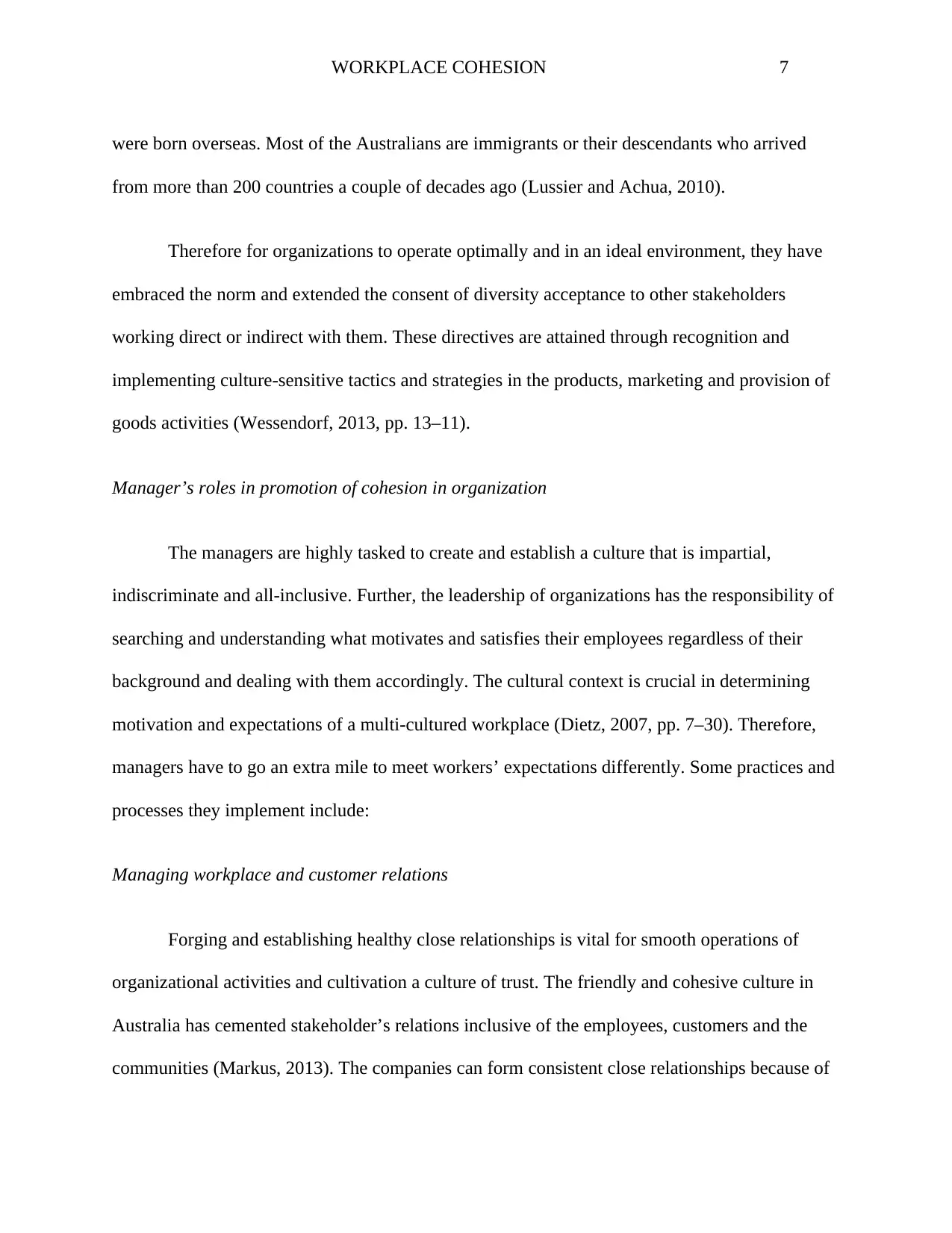
WORKPLACE COHESION 7
were born overseas. Most of the Australians are immigrants or their descendants who arrived
from more than 200 countries a couple of decades ago (Lussier and Achua, 2010).
Therefore for organizations to operate optimally and in an ideal environment, they have
embraced the norm and extended the consent of diversity acceptance to other stakeholders
working direct or indirect with them. These directives are attained through recognition and
implementing culture-sensitive tactics and strategies in the products, marketing and provision of
goods activities (Wessendorf, 2013, pp. 13–11).
Manager’s roles in promotion of cohesion in organization
The managers are highly tasked to create and establish a culture that is impartial,
indiscriminate and all-inclusive. Further, the leadership of organizations has the responsibility of
searching and understanding what motivates and satisfies their employees regardless of their
background and dealing with them accordingly. The cultural context is crucial in determining
motivation and expectations of a multi-cultured workplace (Dietz, 2007, pp. 7–30). Therefore,
managers have to go an extra mile to meet workers’ expectations differently. Some practices and
processes they implement include:
Managing workplace and customer relations
Forging and establishing healthy close relationships is vital for smooth operations of
organizational activities and cultivation a culture of trust. The friendly and cohesive culture in
Australia has cemented stakeholder’s relations inclusive of the employees, customers and the
communities (Markus, 2013). The companies can form consistent close relationships because of
were born overseas. Most of the Australians are immigrants or their descendants who arrived
from more than 200 countries a couple of decades ago (Lussier and Achua, 2010).
Therefore for organizations to operate optimally and in an ideal environment, they have
embraced the norm and extended the consent of diversity acceptance to other stakeholders
working direct or indirect with them. These directives are attained through recognition and
implementing culture-sensitive tactics and strategies in the products, marketing and provision of
goods activities (Wessendorf, 2013, pp. 13–11).
Manager’s roles in promotion of cohesion in organization
The managers are highly tasked to create and establish a culture that is impartial,
indiscriminate and all-inclusive. Further, the leadership of organizations has the responsibility of
searching and understanding what motivates and satisfies their employees regardless of their
background and dealing with them accordingly. The cultural context is crucial in determining
motivation and expectations of a multi-cultured workplace (Dietz, 2007, pp. 7–30). Therefore,
managers have to go an extra mile to meet workers’ expectations differently. Some practices and
processes they implement include:
Managing workplace and customer relations
Forging and establishing healthy close relationships is vital for smooth operations of
organizational activities and cultivation a culture of trust. The friendly and cohesive culture in
Australia has cemented stakeholder’s relations inclusive of the employees, customers and the
communities (Markus, 2013). The companies can form consistent close relationships because of
Paraphrase This Document
Need a fresh take? Get an instant paraphrase of this document with our AI Paraphraser

WORKPLACE COHESION 8
trust and assure working environment. Marketing and servicing culturally diverse domestic and
overseas customers
Ensuring ethical conduct, due diligence, and social responsibility
The traits of people in Australia has changed and assumed a humble and down to earth
personality. This means they will avoid friction and unnecessary aggression or show-offs against
their colleagues. In the long run, cohesion and close relationships are established on these
grounds.
Teams and teamwork
Increased team leader and team member awareness of cultural factors within teams
improve the capacity of all members of the team to contribute. Australians place a high value on
relationships. The Australians never discriminate rather put a high value on relationships (Beam,
2012). This is informed by their belief of future uncertainties that might prompt assistance from
anyone.
Advantages of Cohesion
The present state of culture and workers diversity in Australia has advanced and become
an asset to the organizations producing a good performance. Groups in this country have adapted
into the culture of multi-racialism and diversity because of the increasing need for variant
expertise and world-class skills and knowledge which is an asset and capable of benefiting the
organization with a competitive edge. This is essential because different competencies, skills,
and experience are pooled together to deliver splendid performance. Among the benefits
trust and assure working environment. Marketing and servicing culturally diverse domestic and
overseas customers
Ensuring ethical conduct, due diligence, and social responsibility
The traits of people in Australia has changed and assumed a humble and down to earth
personality. This means they will avoid friction and unnecessary aggression or show-offs against
their colleagues. In the long run, cohesion and close relationships are established on these
grounds.
Teams and teamwork
Increased team leader and team member awareness of cultural factors within teams
improve the capacity of all members of the team to contribute. Australians place a high value on
relationships. The Australians never discriminate rather put a high value on relationships (Beam,
2012). This is informed by their belief of future uncertainties that might prompt assistance from
anyone.
Advantages of Cohesion
The present state of culture and workers diversity in Australia has advanced and become
an asset to the organizations producing a good performance. Groups in this country have adapted
into the culture of multi-racialism and diversity because of the increasing need for variant
expertise and world-class skills and knowledge which is an asset and capable of benefiting the
organization with a competitive edge. This is essential because different competencies, skills,
and experience are pooled together to deliver splendid performance. Among the benefits
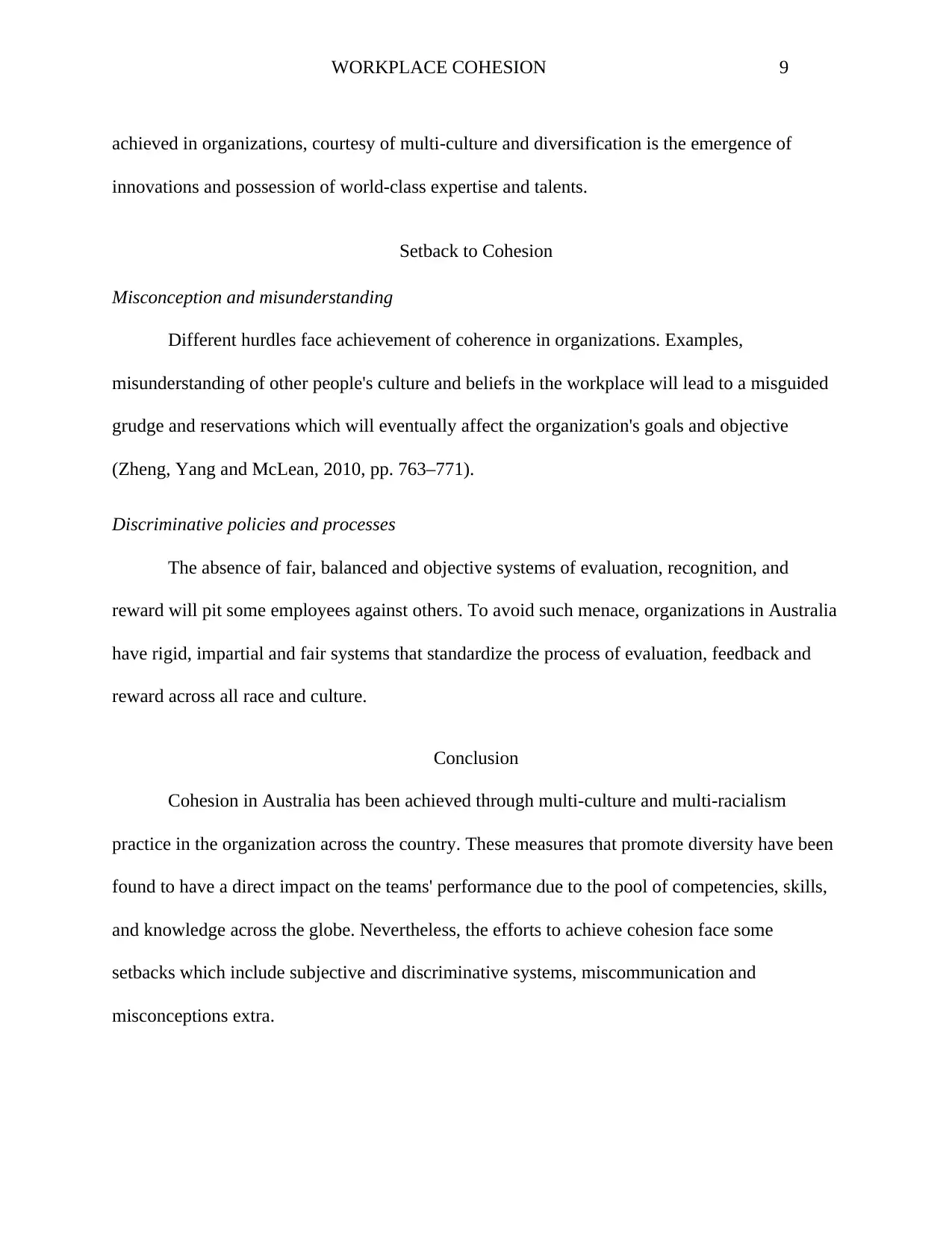
WORKPLACE COHESION 9
achieved in organizations, courtesy of multi-culture and diversification is the emergence of
innovations and possession of world-class expertise and talents.
Setback to Cohesion
Misconception and misunderstanding
Different hurdles face achievement of coherence in organizations. Examples,
misunderstanding of other people's culture and beliefs in the workplace will lead to a misguided
grudge and reservations which will eventually affect the organization's goals and objective
(Zheng, Yang and McLean, 2010, pp. 763–771).
Discriminative policies and processes
The absence of fair, balanced and objective systems of evaluation, recognition, and
reward will pit some employees against others. To avoid such menace, organizations in Australia
have rigid, impartial and fair systems that standardize the process of evaluation, feedback and
reward across all race and culture.
Conclusion
Cohesion in Australia has been achieved through multi-culture and multi-racialism
practice in the organization across the country. These measures that promote diversity have been
found to have a direct impact on the teams' performance due to the pool of competencies, skills,
and knowledge across the globe. Nevertheless, the efforts to achieve cohesion face some
setbacks which include subjective and discriminative systems, miscommunication and
misconceptions extra.
achieved in organizations, courtesy of multi-culture and diversification is the emergence of
innovations and possession of world-class expertise and talents.
Setback to Cohesion
Misconception and misunderstanding
Different hurdles face achievement of coherence in organizations. Examples,
misunderstanding of other people's culture and beliefs in the workplace will lead to a misguided
grudge and reservations which will eventually affect the organization's goals and objective
(Zheng, Yang and McLean, 2010, pp. 763–771).
Discriminative policies and processes
The absence of fair, balanced and objective systems of evaluation, recognition, and
reward will pit some employees against others. To avoid such menace, organizations in Australia
have rigid, impartial and fair systems that standardize the process of evaluation, feedback and
reward across all race and culture.
Conclusion
Cohesion in Australia has been achieved through multi-culture and multi-racialism
practice in the organization across the country. These measures that promote diversity have been
found to have a direct impact on the teams' performance due to the pool of competencies, skills,
and knowledge across the globe. Nevertheless, the efforts to achieve cohesion face some
setbacks which include subjective and discriminative systems, miscommunication and
misconceptions extra.
⊘ This is a preview!⊘
Do you want full access?
Subscribe today to unlock all pages.

Trusted by 1+ million students worldwide

WORKPLACE COHESION 10
Reference
Beam, M. (2012). Emotional Intelligence and Team Cohesiveness. Marshall University. Theses,
Dissertations, and Capstones.
Biswas, S. (2010). The relationship between psychological climate and turnover intentions and
its impact on the organizational effectiveness: a study in Indian organizations. IIMB Manage,
pp. 102–110
Daft, R. and Marcic, D. (2009). Understanding Management (6th ed). Mason, Ohio: South-
Western Cengage Learning
Demireva, N. (2014). Briefing: Immigration, Diversity and Social Cohesion. The Migration
Observatory at the University of theOxford.
Dietz, G. (2007). Keyword: Cultural diversity. A guide through the debate. Zeitschrift für
Erziehungswissenschaft, pp. 7–30
Hofstede, G. (2010). Cultures and organizations: Software of the mind: Intercultural
cooperation and its importance for survival. New York: McGraw-Hill.
Huang, C. and Hsueh, S. (2007). A study on the relationship between intellectual capital and the
business performance in the engineering consulting industry: a path analysis approach. J Civil
Eng Manager, pp. 265–271
Lussier, R. and Achua, C. (2010). Leadership: Theory, Application, & Skill Development (4th
ed.). Mason, Ohio: South-Western Cengage Learning
Markus, P. (2013). Mapping Social Cohesion 2013. The Scanlon Foundation Surveys National
Report.
Reference
Beam, M. (2012). Emotional Intelligence and Team Cohesiveness. Marshall University. Theses,
Dissertations, and Capstones.
Biswas, S. (2010). The relationship between psychological climate and turnover intentions and
its impact on the organizational effectiveness: a study in Indian organizations. IIMB Manage,
pp. 102–110
Daft, R. and Marcic, D. (2009). Understanding Management (6th ed). Mason, Ohio: South-
Western Cengage Learning
Demireva, N. (2014). Briefing: Immigration, Diversity and Social Cohesion. The Migration
Observatory at the University of theOxford.
Dietz, G. (2007). Keyword: Cultural diversity. A guide through the debate. Zeitschrift für
Erziehungswissenschaft, pp. 7–30
Hofstede, G. (2010). Cultures and organizations: Software of the mind: Intercultural
cooperation and its importance for survival. New York: McGraw-Hill.
Huang, C. and Hsueh, S. (2007). A study on the relationship between intellectual capital and the
business performance in the engineering consulting industry: a path analysis approach. J Civil
Eng Manager, pp. 265–271
Lussier, R. and Achua, C. (2010). Leadership: Theory, Application, & Skill Development (4th
ed.). Mason, Ohio: South-Western Cengage Learning
Markus, P. (2013). Mapping Social Cohesion 2013. The Scanlon Foundation Surveys National
Report.
Paraphrase This Document
Need a fresh take? Get an instant paraphrase of this document with our AI Paraphraser
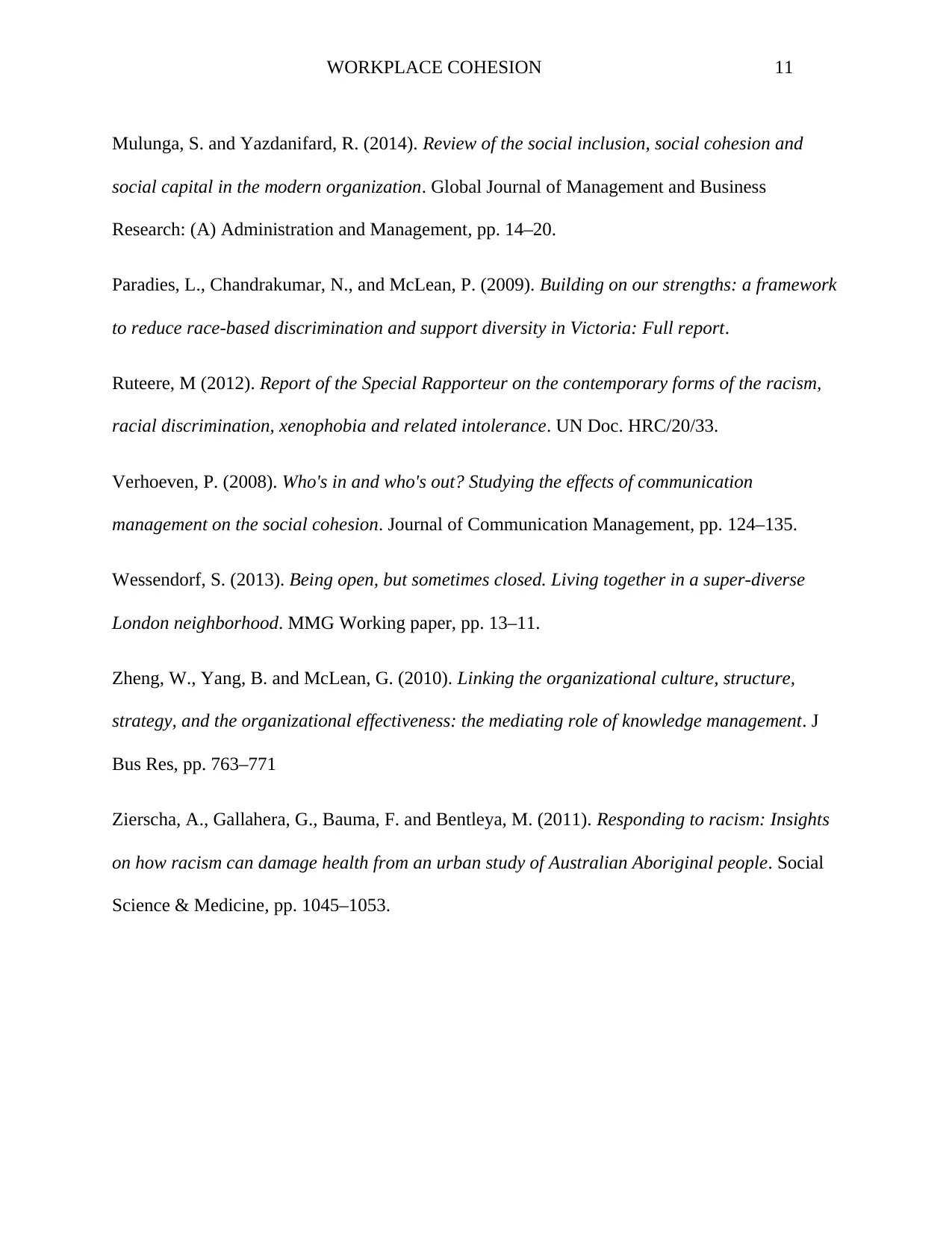
WORKPLACE COHESION 11
Mulunga, S. and Yazdanifard, R. (2014). Review of the social inclusion, social cohesion and
social capital in the modern organization. Global Journal of Management and Business
Research: (A) Administration and Management, pp. 14–20.
Paradies, L., Chandrakumar, N., and McLean, P. (2009). Building on our strengths: a framework
to reduce race-based discrimination and support diversity in Victoria: Full report.
Ruteere, M (2012). Report of the Special Rapporteur on the contemporary forms of the racism,
racial discrimination, xenophobia and related intolerance. UN Doc. HRC/20/33.
Verhoeven, P. (2008). Who's in and who's out? Studying the effects of communication
management on the social cohesion. Journal of Communication Management, pp. 124–135.
Wessendorf, S. (2013). Being open, but sometimes closed. Living together in a super-diverse
London neighborhood. MMG Working paper, pp. 13–11.
Zheng, W., Yang, B. and McLean, G. (2010). Linking the organizational culture, structure,
strategy, and the organizational effectiveness: the mediating role of knowledge management. J
Bus Res, pp. 763–771
Zierscha, A., Gallahera, G., Bauma, F. and Bentleya, M. (2011). Responding to racism: Insights
on how racism can damage health from an urban study of Australian Aboriginal people. Social
Science & Medicine, pp. 1045–1053.
Mulunga, S. and Yazdanifard, R. (2014). Review of the social inclusion, social cohesion and
social capital in the modern organization. Global Journal of Management and Business
Research: (A) Administration and Management, pp. 14–20.
Paradies, L., Chandrakumar, N., and McLean, P. (2009). Building on our strengths: a framework
to reduce race-based discrimination and support diversity in Victoria: Full report.
Ruteere, M (2012). Report of the Special Rapporteur on the contemporary forms of the racism,
racial discrimination, xenophobia and related intolerance. UN Doc. HRC/20/33.
Verhoeven, P. (2008). Who's in and who's out? Studying the effects of communication
management on the social cohesion. Journal of Communication Management, pp. 124–135.
Wessendorf, S. (2013). Being open, but sometimes closed. Living together in a super-diverse
London neighborhood. MMG Working paper, pp. 13–11.
Zheng, W., Yang, B. and McLean, G. (2010). Linking the organizational culture, structure,
strategy, and the organizational effectiveness: the mediating role of knowledge management. J
Bus Res, pp. 763–771
Zierscha, A., Gallahera, G., Bauma, F. and Bentleya, M. (2011). Responding to racism: Insights
on how racism can damage health from an urban study of Australian Aboriginal people. Social
Science & Medicine, pp. 1045–1053.
1 out of 11
Related Documents
Your All-in-One AI-Powered Toolkit for Academic Success.
+13062052269
info@desklib.com
Available 24*7 on WhatsApp / Email
![[object Object]](/_next/static/media/star-bottom.7253800d.svg)
Unlock your academic potential
Copyright © 2020–2025 A2Z Services. All Rights Reserved. Developed and managed by ZUCOL.




